Every year in the night of October 31st, horrible creatures are roaming the streets and houses and gardens are eerily beautiful decorated. Where does this tradition come from? Why do we dress up and try to scare people? Why do we carve spooky faces into pumpkins?
Halloween has its origins in Europe, it’s a very old Holiday that goes back to the ancient Celts who lived many centuries ago in Ireland, Scotland and other parts of Europe.
The night from October 31st to November 1st is a very special night; it was called the festival of the dead Samhain, what actually means the end of summer. The Celtic calendar year ended October 31st. Summer was over and winter, the dark season, began.
The ancient Celts celebrated this night with big bonfires. People were afraid of the dead and they started to dress up as creepy as possible. Death should think that the costumed people had already died and he wasn’t needed at their houses. The Celts believed that at the time of Samhain, more so than any other time of the year, the ghosts of the dead were able to mingle with the living. People gathered to sacrifice animals, fruits, and vegetables, they lit bonfires in honor of the dead, to aid them on their journey, and to keep them away from the living.
Samhain became the Halloween we are familiar with when Christian missionaries attempted to change the religious practices of the Celtic people. In the early centuries of the first millennium A.D., before missionaries converted them to Christianity, the Celts practiced an elaborate religion through their priestly caste, the Druids, who were priests, poets, scientists and scholars all at once. As religious leaders, ritual specialists, and bearers of learning, the Druids were not unlike the very missionaries and monks who were to Christianize their people and brand them evil devil worshipers.
As a result of their efforts to wipe out “pagan” holidays, such as Samhain, the Christians succeeded in effecting major transformations in it. In 601 A.D. Pope Gregory the First issued a now famous edict to his missionaries concerning the native beliefs and customs of the peoples he hoped to convert. Rather than try to obliterate native peoples’ customs and beliefs, the pope instructed his missionaries to use them: if a group of people worshiped a tree, rather than cut it down, he advised them to consecrate it to Christ and allow its continued worship.
Samhain, was decidedly pagan. While missionaries identified their holy days with those observed by the Celts, they branded the earlier religion’s supernatural deities as evil, and associated them with the devil. As representatives of the rival religion, Druids were considered evil worshipers of devilish or demonic gods and spirits. The Celtic underworld inevitably became identified with the Christian Hell.
The effects of this policy were to diminish but not totally eradicate the beliefs in the traditional gods. Celtic belief in supernatural creatures persisted, while the church made deliberate attempts to define them as being not merely dangerous, but malicious. Followers of the old religion went into hiding and were branded as witches.
The Christian feast of All Saints was assigned to November 1st. The day honored every Christian saint, especially those that did not otherwise have a special day devoted to them. This feast day was meant to substitute for Samhain, to draw the devotion of the Celtic peoples, and, finally, to replace it forever. That did not happen, but the traditional Celtic deities diminished in status, becoming fairies or leprechauns of more recent traditions.
The old beliefs associated with Samhain never died out entirely. The powerful symbolism of the traveling dead was too strong, and perhaps too basic to the human psyche, to be satisfied with the new, more abstract Catholic feast honoring saints.
All Saints Day, otherwise known as All Hallows (hallowed means sanctified or holy), continued the ancient Celtic traditions. The evening prior to the day was the time of the most intense activity, both human and supernatural. People continued to celebrate All Hallows Eve as a time of the wandering dead, but the supernatural beings were now thought to be evil. The folk continued to propitiate those spirits (and their masked impersonators) by setting out gifts of food and drink. Subsequently, All Hallows Eve became Hallow Evening, which became Hallowe’en–an ancient Celtic, pre-Christian New Year’s Day in contemporary dress.
Many supernatural creatures became associated with All Hallows. In Ireland fairies were numbered among the legendary creatures who roamed on Halloween. An old folk ballad called “Allison Gross” tells the story of how the fairy queen saved a man from a witch’s spell on Halloween.
O Allison Gross, that lives in yon tower
the ugliest witch int he North Country…
She’s turned me into an ugly worm
and gard me toddle around a tree…
But as it fell out last Hallow even
When the seely [fairy] court was riding by,
the Queen lighted down on a gowany bank
Not far from the tree where I wont to lie…
She’s change me again to my own proper shape
And I no more toddle about the tree.
In old England cakes were made for the wandering souls, and people went “a’ soulin'” for these “soul cakes.” Halloween, a time of magic, also became a day of divination, with a host of magical beliefs: for instance, if persons hold a mirror on Halloween and walk backwards down the stairs to the basement, the face that appears in the mirror will be their next lover.
Virtually all present Halloween traditions can be traced to the ancient Celtic day of the dead. Halloween is a holiday of many mysterious customs, but each one has a history, or at least a story behind it. The wearing of costumes, for instance, and roaming from door to door demanding treats can be traced to the Celtic period and the first few centuries of the Christian era, when it was thought that the souls of the dead were out and around, along with fairies, witches, and demons. Offerings of food and drink were left out to placate them. As the centuries wore on, people began dressing like these dreadful creatures, performing antics in exchange for food and drink. This practice is called mumming, from which the practice of trick-or-treating evolved. To this day, witches, ghosts, and skeleton figures of the dead are among the favorite disguises. Halloween also retains some features that harken back to the original harvest holiday of Samhain, such as the customs of bobbing for apples and carving vegetables, as well as the fruits, nuts, and spices cider associated with the day
So how did Halloween come to America?
In the second half of the nineteenth century, America was flooded with new immigrants. These new immigrants, especially the millions of Irish fleeing Ireland’s potato famine of 1846, helped to popularize the celebration of Halloween nationally. Taking from Irish and English traditions, Americans began to dress up in costumes and go house to house asking for food or money, a practice that eventually became today’s “trick-or-treat” tradition. Young women believed that on Halloween they could divine the name or appearance of their future husband by doing tricks with yarn, apple parings or mirrors.
In the late 1800s, there was a move in America to mold Halloween into a holiday more about community and neighborly get-togethers than about ghosts, pranks and witchcraft. At the turn of the century, Halloween parties for both children and adults became the most common way to celebrate the day. Parties focused on games, foods of the season and festive costumes. Parents were encouraged by newspapers and community leaders to take anything “frightening” or “grotesque” out of Halloween celebrations. Because of these efforts, Halloween lost most of its superstitious and religious overtones by the beginning of the twentieth century.
By the 1920s and 1930s, Halloween had become a secular, but community-centered holiday, with parades and town-wide parties as the featured entertainment. Despite the best efforts of many schools and communities, vandalism began to plague Halloween celebrations in many communities during this time. By the 1950s, town leaders had successfully limited vandalism and Halloween had evolved into a holiday directed mainly at the young. Due to the high numbers of young children during the fifties baby boom, parties moved from town civic centers into the classroom or home, where they could be more easily accommodated. Between 1920 and 1950, the centuries-old practice of trick-or-treating was also revived. Trick-or-treating was a relatively inexpensive way for an entire community to share the Halloween celebration. In theory, families could also prevent tricks being played on them by providing the neighborhood children with small treats. A new American tradition was born, and it has continued to grow. Today, Americans spend an estimated $6 billion annually on Halloween, making it the country’s second largest commercial holiday.
(Source: The American Folk life Center, Wikipedia, Die Geschichte von Halloween, Celtic History, History.com)
I found all of it so interesting that I had to share it. I wish all of you a spooky Halloween.

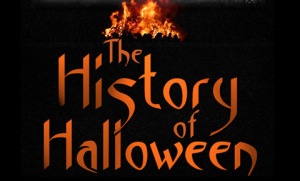
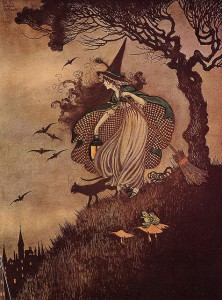
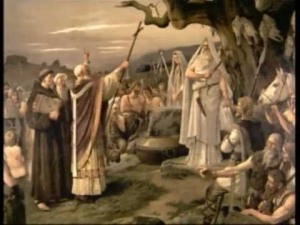

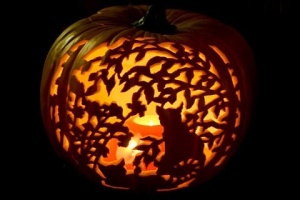

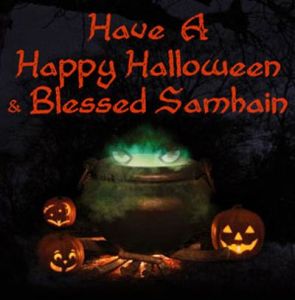

It was a spectacular night. Hope you enjoyed yours.
LikeLiked by 1 person
Wonderful share… 🙂 hope you had a wonderful Halloween, xx Love Sue xx
LikeLike
Very interesting write. Thanks.
LikeLiked by 1 person
Such an interesting post… I have never heard of the original Samhain, a decidedly irish pagan celebration as you teach us… Also it is quite amazing to learn how it influenced Catholic and Christians and how it finally landed in the States…
Thanks so much for sharing… Sending best wishes. Aquileana 🐉☀️
LikeLiked by 1 person
I found it quite fascinating myself.
LikeLike
I would love to know where the sepia picture of the witch on the hill came from. I love it and would love to have a copy of this print .
LikeLiked by 1 person
Very fascinating read. History is interesting.
LikeLiked by 1 person
Have I evet mentioned I was a druid in a previous life? In the order of Bards… 🙂
LikeLike
So, where are my lollies?
LikeLiked by 1 person
Well, come on over. I am sitting on my desk and have my eye on the street, I will see you pulling up 🙂
LikeLike
I’ve always found it fascinating how each new religion “takes over” the holidays of its predecessors. Not just Christianity. Every religion has done it, some more blatantly than others. It’s why I find the history of religion so fascinating.
LikeLiked by 1 person
I find religion and different believes very fascinating, even though I am non religious. There was a time when I read books about old ancient Celtic ceremonies and rituals and I was very surprised when I realized how many of them were just modernized by different cults and religions afterwards.
LikeLike